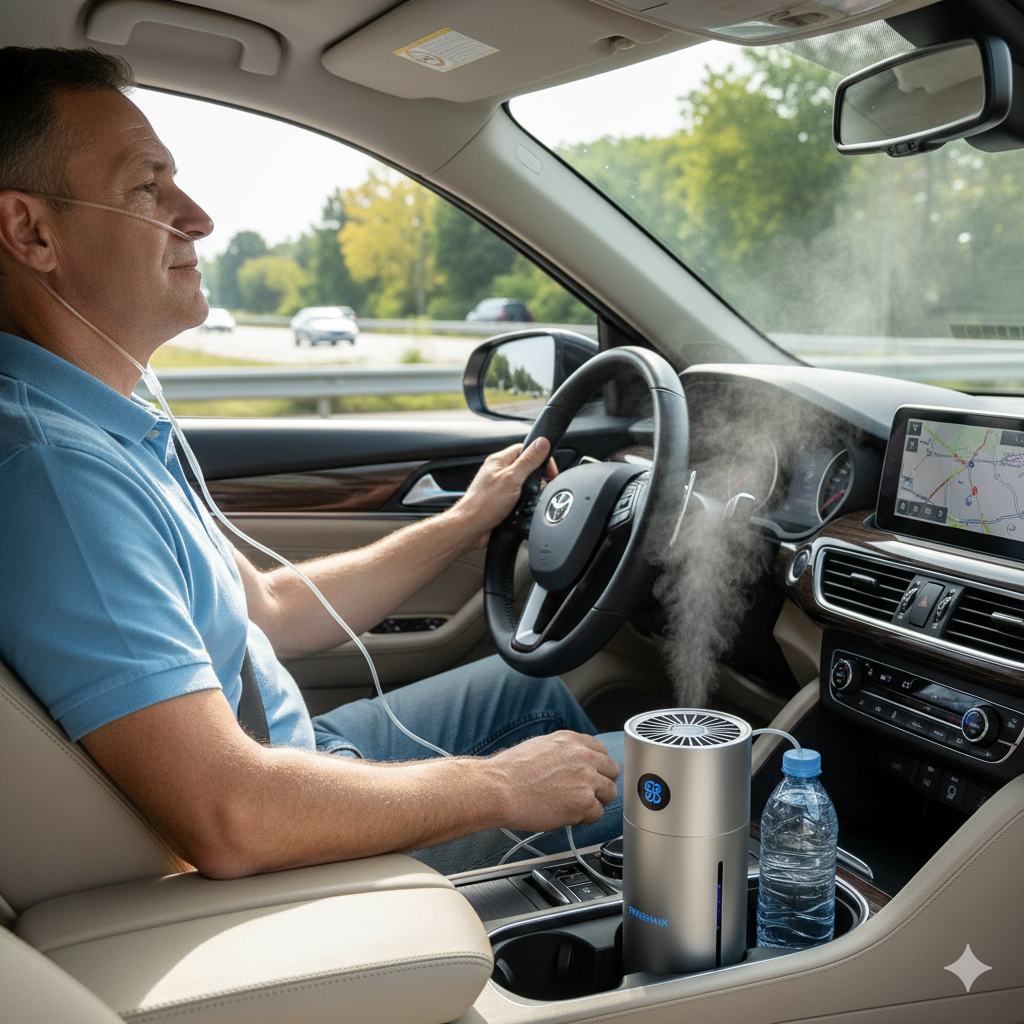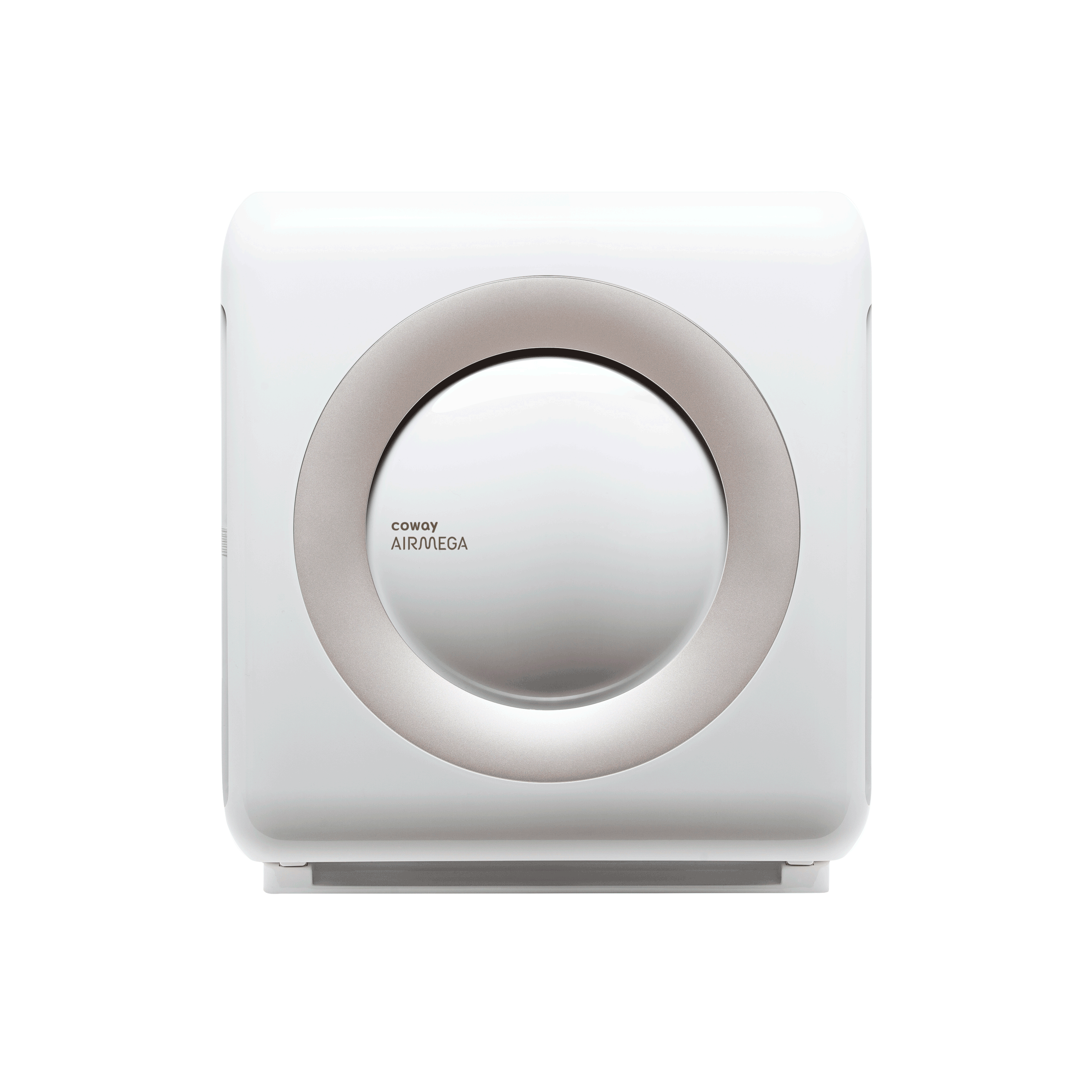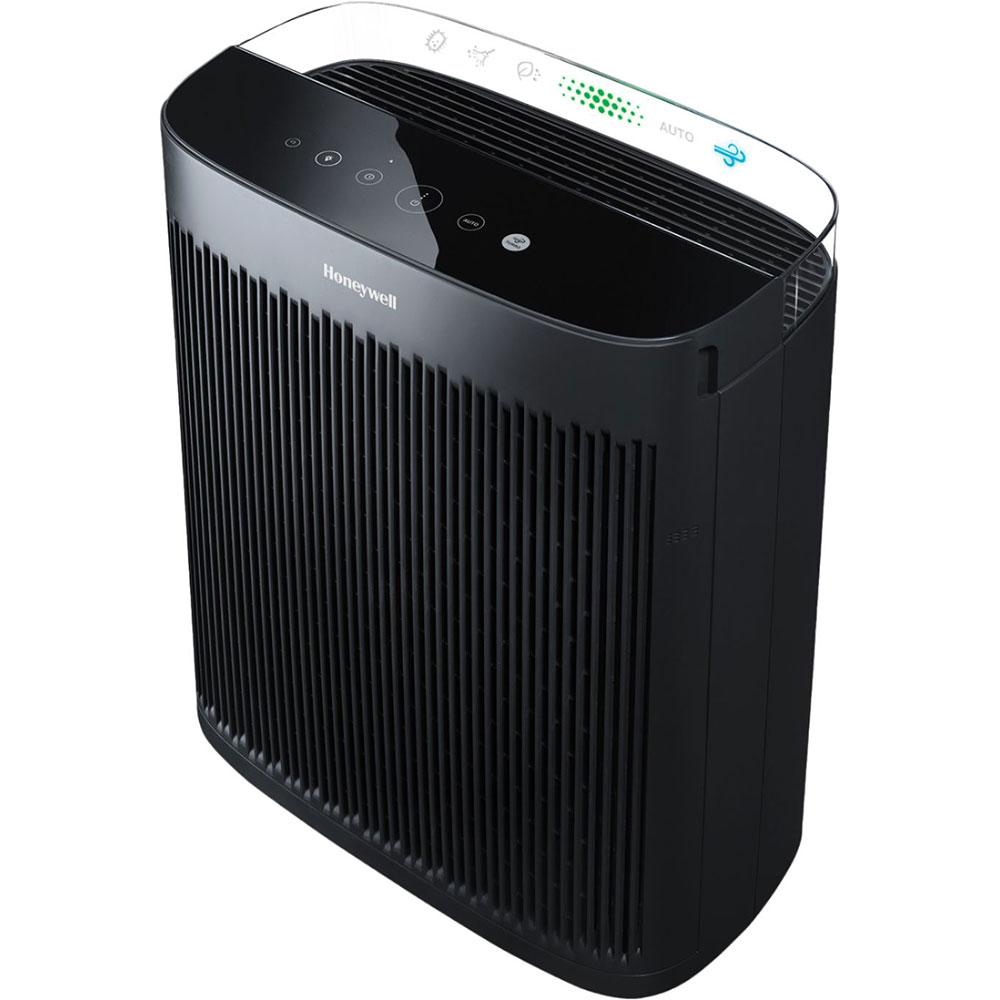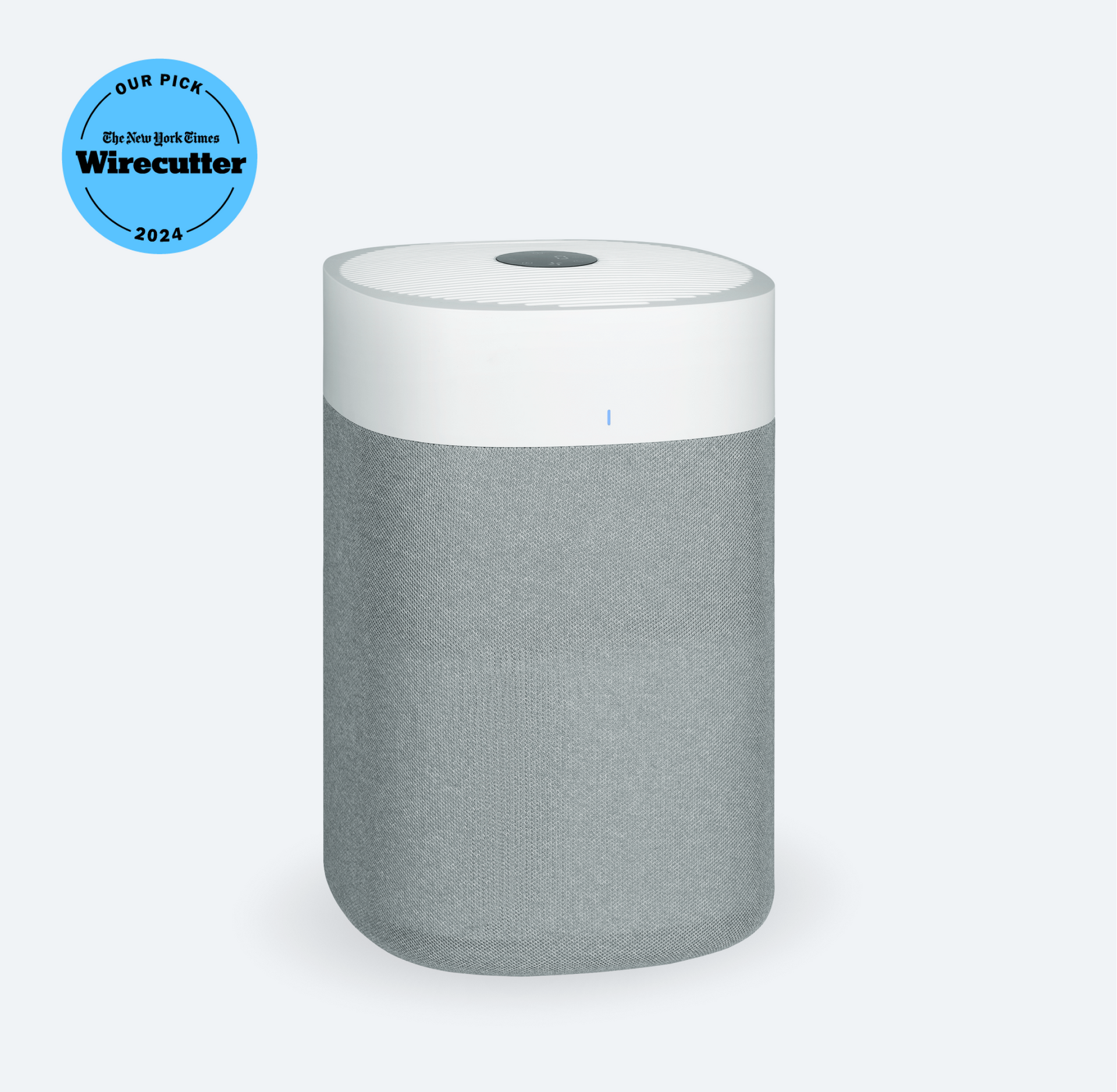Your car's air quality matters, especially if you have COPD. Pollutants, allergens, and irritants can accumulate inside, worsening symptoms like coughing and shortness of breath. The solution? Upgrade your cabin air filter and consider a portable air purifier. Here's a quick breakdown:
- Cabin Filters: HEPA filters trap fine particles like dust and pollen, while activated carbon filters absorb odors and chemical fumes. Combination filters handle both.
- Portable Air Purifiers: These add extra protection, especially in older cars, rideshares, or polluted areas. Look for features like True HEPA filtration, activated carbon layers, and compact designs.
- Ventilation Tips: Use recirculation mode in traffic or polluted areas and switch to fresh air mode in cleaner environments. Keep windows closed in high-pollution zones.
Regular filter replacements (every 12–15 months) and smart driving habits can significantly improve the air you breathe, reducing COPD triggers and making your drives more comfortable.
Improving COPD Symptoms with HEPA Air Filters: Insights from the CLEAN AIR Study | 2 Minute Update
Cabin Air Filters: HEPA vs Activated Carbon
Your car's cabin air filter plays a crucial role in keeping the interior air free from harmful pollutants. HEPA filters and activated carbon filters use different methods to protect against these irritants, and knowing how they work can help you choose the best option for managing your COPD symptoms.
While standard paper filters only block larger particles, they fall short when it comes to capturing the tiny irritants that can aggravate COPD. Upgrading to a HEPA or activated carbon filter can make a noticeable difference in the air quality inside your vehicle.
How HEPA Filters Work
HEPA filters are designed like intricate nets, capturing microscopic particles in the air. They trap at least 99.97% of particles that are 0.3 microns or larger - to put that in perspective, that’s about 300 times smaller than a human hair.
These filters work through three mechanisms: direct impaction, where larger particles collide with the fibers; interception, where particles follow airflow and get caught; and diffusion, where smaller particles are trapped as they move erratically. Together, these processes make HEPA filters highly effective at capturing dust mites, pollen, pet dander, smoke particles, and bacteria - all common triggers for COPD symptoms.
If you live in an area with frequent pollen, dust storms, or wildfire smoke, a HEPA filter can drastically reduce your exposure to these irritants while driving. However, there’s a catch: HEPA filters don’t address gases, odors, or chemical vapors. So, that diesel exhaust smell from the truck ahead of you? A HEPA filter won’t block it.
How Activated Carbon Filters Work
Activated carbon filters take on what HEPA filters can’t: the invisible threats. These filters are packed with millions of tiny pores that act like molecular traps, absorbing gas molecules and chemical vapors as air moves through them.
To give you an idea of their efficiency, just one gram of activated carbon has over 1,000 square feet of surface area thanks to its porous structure. This massive surface area allows it to effectively capture volatile organic compounds (VOCs), exhaust fumes, industrial emissions, and even strong odors from perfumes or air fresheners.
For those sensitive to chemical smells or living in areas with heavy traffic or industrial pollution, activated carbon filters can provide much-needed relief. However, they aren’t as effective at capturing physical particles like dust and pollen. Additionally, their effectiveness decreases over time as the pores fill up with trapped molecules, requiring regular replacement.
Picking the Right Cabin Filter for Your Car
Choosing between HEPA and activated carbon filters comes down to your primary irritants - particles or chemicals. Your driving environment and specific triggers should guide your decision. If dust, pollen, or smoke are your main concerns, opt for a HEPA filter. If you’re more bothered by chemical odors or exhaust fumes, an activated carbon filter is the way to go.
Many modern vehicles now support combination filters that include both HEPA and activated carbon layers. These hybrid filters offer protection against both particles and gases, though they tend to be pricier and may need more frequent replacements.
Finding the right filter for your car is straightforward. Most auto parts stores have lookup tools where you can enter your car’s year, make, and model to find compatible options. Brands like Fram, K&N, and Mann-Filter produce OEM-fit replacements for most cars sold in the U.S. since 2000.
For older vehicles without cabin air filters, aftermarket solutions are available. Some companies make universal filters that can be installed into the ventilation system, though professional installation is often required.
Be sure to check your owner’s manual for the correct filter specifications before purchasing. Using the wrong size filter can reduce your car’s heating and cooling efficiency or even damage the ventilation system.
When and How to Replace Your Cabin Air Filter
Replacing your cabin air filter regularly is key to maintaining clean air inside your car and reducing potential COPD triggers. Under typical driving conditions, it’s recommended to replace the filter every 15,000 miles or once a year. For the exact steps, consult your vehicle’s owner’s manual, as the process can vary depending on the make and model. Staying on top of this maintenance improves air quality and keeps your system running smoothly[1].
Portable Air Purifiers for Cars
If your car's built-in cabin filter isn’t cutting it - or you frequently use rideshares or rental cars - portable air purifiers can offer an extra layer of protection against airborne particles that might aggravate COPD symptoms. These devices are designed to trap pollutants, allergens, and irritants, improving the air quality inside your vehicle.
They’re especially helpful in situations like wildfire smoke, heavy traffic, or construction zones where air quality tends to plummet. Working alongside your car’s cabin filter, portable purifiers can help reduce potential COPD triggers, even in challenging driving conditions.
What Features to Look For
To find the right purifier for your needs, keep an eye out for these features:
- True HEPA Filtration: Choose models labeled "True HEPA" for the best performance in capturing fine airborne particles. Avoid "HEPA-like" filters, which are less effective.
- Activated Carbon Layers: A purifier with activated carbon can absorb odors and chemical vapors, such as those from exhaust fumes or cigarette smoke. This combination of HEPA and carbon filtration is especially useful for managing COPD symptoms.
- Power Options: Look for purifiers with flexible power sources. Many offer 12V adapters for your car’s power outlet, while others use USB connections compatible with portable batteries or chargers. Some models come with both options for added convenience.
- Compact Size: Since space is limited in most vehicles, compact purifiers are ideal. Larger units may offer better filtration but need to be securely mounted to avoid shifting while driving.
- Quiet Operation: Noise can be distracting in a car, so opt for models known for their low noise output to maintain a peaceful environment.
Best Purifiers for Different Situations
Here’s how different types of portable purifiers can suit various needs:
- Cup-Holder Purifiers: Designed to fit snugly into your car’s cup holder, these are perfect for compact cars and sedans. They efficiently circulate filtered air throughout the cabin.
- Compact Desktop Units: Better suited for larger vehicles like SUVs and trucks, these purifiers have stronger fans and larger filters. Look for units with secure mounting options, such as non-slip pads or brackets, to keep them stable while driving.
- Travel-Sized Purifiers: Lightweight and battery-powered, these are ideal for rideshares or rental cars. Small enough to fit in a purse or briefcase, they’re easy to carry and set up wherever needed.
- Heavy-Duty Models with Dual Filtration: Equipped with powerful fans and both HEPA and activated carbon filters, these are great for high-pollution areas or during wildfire events.
Do Portable Purifiers Actually Work?
Research confirms that portable purifiers can significantly improve air quality in confined spaces like cars, especially when combined with good air circulation. However, their effectiveness decreases when windows are open or during heavy acceleration.
In the enclosed environment of a vehicle, a quality purifier can quickly enhance cabin air quality. While they’re not a substitute for maintaining your car’s cabin filter, they serve as an excellent additional layer of protection.
sbb-itb-3e96dba
Daily Habits for Cleaner Car Air
Making small changes to your daily routines can complement your car's filters and purifiers, helping to minimize COPD triggers and improve the air quality inside your vehicle. By tweaking how you use your car's ventilation system, you can create a healthier environment for your drives.
When to Use Recirculation vs. Fresh Air
Your car’s recirculation mode is a handy tool for limiting the entry of polluted air from outside by reusing the air already inside the cabin. Here are some situations where this mode is particularly useful:
- Driving in heavy traffic or stop-and-go conditions.
- Encountering wildfire smoke or visibly poor air quality.
- Passing areas with high emissions, such as construction zones, industrial areas, or near large vehicles.
- Navigating tunnels where exhaust fumes can accumulate.
Switch to fresh air mode in these scenarios:
- Driving on open highways with light traffic and cleaner air.
- When your windows start to fog up or the air inside feels stale.
- After prolonged use of recirculation mode to refresh the cabin air.
While many modern vehicles can automatically adjust these settings based on air quality sensors, manually managing them can provide extra comfort and protection, especially during COPD flare-ups or in heavily polluted areas.
Adjusting your window settings can also enhance the effectiveness of these ventilation modes.
How to Manage Your Car Windows
Keeping your windows closed is crucial when driving in polluted areas, as it allows your car's filters to work more efficiently. Opening windows in heavy traffic or smoggy conditions can introduce more pollutants into the cabin.
If you need fresh air, try slightly cracking your windows while driving at higher speeds, like on a highway. The faster airflow helps disperse pollutants more effectively compared to city traffic. On hot days, it’s a good idea to air out your car before getting in. Run the air conditioner briefly with the windows partially open to clear out built-up heat and indoor pollutants without letting in too much outside air.
Avoid idling with your windows down in areas where exhaust fumes or other pollutants could easily enter the cabin.
Road Trip Air Quality Checklist
Long drives require extra attention to maintaining clean air inside your vehicle. Here’s a quick checklist to help you prepare:
- Replace your cabin filter before your trip, especially if it’s overdue for a change.
- Pack spare supplies, like an extra filter and a basic toolkit, in case you need to make adjustments on the road.
- Ensure any portable air purifiers are fully charged and functioning properly.
- Check air quality forecasts using reliable sources like AirNow or PurpleAir to plan your route and avoid areas with poor conditions.
- Keep an emergency kit in your car with masks, medications, and other essentials, and store them in an easy-to-reach spot.
- Monitor your car’s air conditioning and ventilation during the trip. If you notice strange odors or reduced airflow, adjust the settings or stop to address the issue.
Product Comparison Table
Finding the right air filtration solution for your car depends on your needs, the type of vehicle you drive, and your budget. Below is a breakdown of top-rated cabin filters and portable purifiers to help you decide what works best for you.
| Product Type | Use Case | Power Source | Replacement Schedule | Annual Cost | Best For |
|---|---|---|---|---|---|
| HEPA Cabin Filter | OEM replacement for most vehicles | Vehicle's HVAC system | Every 15,000–30,000 miles or 12 months | $35–$100 | Daily commuting, general air filtration |
| Activated Carbon Filter | Odor and gas removal | Vehicle's HVAC system | Every 15,000–30,000 miles or 12 months | $35–$100 | Heavy traffic, industrial areas, smoke |
| Cup-Holder Purifier | Small cars, rideshares | 12V/USB | Main filter: 6–12 months; Pre-filter: 1–3 months | $50–$100+ | Rideshare drivers, compact vehicles |
| Portable Travel Purifier | Road trips, multiple vehicles | USB or battery powered | Main filter: 6–12 months; Pre-filter: 1–3 months | $50–$100+ | Frequent travelers, rental cars |
| Premium Compact Purifier | Enhanced filtration | 12V adapter | Main filter: Approx. $74 per replacement | $74+ annually | Severe COPD, high pollution areas |
Key Considerations
Replacement Schedules
The suggested replacement timelines are general guidelines and may need adjustment if you frequently drive in areas with heavy pollution. Cabin filters are straightforward to replace, often just once or twice a year. Portable purifiers, on the other hand, require more frequent maintenance. Pre-filters typically need cleaning or replacing every 1–3 months, while main HEPA filters last about 6–12 months.
Power Sources
Power options can influence convenience and performance. USB-powered purifiers are versatile and work across different vehicles, but they might not deliver as much airflow. Devices that connect to your car's 12V outlet generally offer stronger performance but require a dedicated outlet.
Annual Costs
Understanding ongoing expenses can help you budget effectively. Cabin filters usually cost between $35 and $100 per year, depending on the type and brand. Portable purifiers often have higher annual costs due to frequent filter replacements, which can range from $50 to over $100. For instance, the Intellipure Compact Main Filter Replacement costs about $74 each time.
Regular filter maintenance and timely replacements are essential to ensure you're breathing the cleanest air possible while driving.
Conclusion: Better Air Quality for COPD Management
Taking steps to improve air quality inside your car can make a big difference for those managing COPD. By using effective cabin filters, portable air purifiers, and adopting smart driving habits, you can create a more breathable environment and reduce discomfort while on the road.
Cabin filters are your first line of defense against pollutants. Whether you opt for a HEPA filter to trap fine particles or an activated carbon filter to tackle odors and gases, regular maintenance is key. Following your car’s recommended schedule for filter replacement ensures your HVAC system works efficiently. For those with severe COPD or who often drive in polluted areas, a portable air purifier can offer extra protection - this is particularly useful in older cars or rideshares that may lack advanced filtration systems.
Your driving habits matter too. Adjusting your ventilation settings based on traffic and air conditions can help. For instance, using fresh air mode on highways can minimize stuffiness, while pre-cooling your car or cracking the windows in light traffic can further improve air circulation. These small changes can make a big impact on your breathing comfort.
Combining these equipment upgrades with thoughtful habits creates a strong defense against poor air quality. Start by checking your car’s current cabin filter and sticking to the replacement schedule. If you spend a lot of time in your vehicle or frequently use rideshares, consider adding a portable purifier to maintain a consistently clean environment.
With the right filter, regular maintenance, and a few simple adjustments, every drive can support healthier lungs and greater comfort.
FAQs
To determine if your car can use a combination HEPA and activated carbon cabin filter, start by checking the filter's packaging or product description for compatibility information. Specifically, look for details indicating the inclusion of both HEPA and activated carbon layers. Additionally, consult your vehicle’s owner’s manual or reach out to the manufacturer to confirm which filter types are suitable for your car model.
If you’re dealing with weaker airflow from your car’s vents, strange smells in the cabin, or worsening allergy symptoms during your drives, it might be time to replace the cabin air filter. Other warning signs include persistently foggy windows that are hard to clear and odd noises coming from the fan when it’s running.
Regularly swapping out your cabin air filter ensures cleaner air inside your vehicle and helps your HVAC system run smoothly. To stay on top of it, refer to your vehicle’s owner manual for the recommended replacement interval, or inspect the filter if you suspect it’s blocked.








